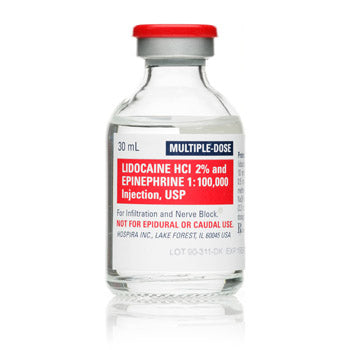Lidocaine HCL 2% and Epinephrine 1% 1:100,000 for Injection 30 mL Multiple Dose, 25/Pack (Rx)
(Note: We don’t Fill Personal Prescriptions)
How to Order:
Lidocaine HCL 2% and Epinephrine 1% 1:100,000 for Injection is used as a local anesthetic to provide pain relief during surgical or dental procedures. Lidocaine works by blocking nerve impulses, preventing pain sensations. The addition of epinephrine, a vasoconstrictor, reduces bleeding and prolongs the anesthetic effect by constricting blood vessels, which keeps the anesthetic in the desired area longer. This combination is ideal for procedures requiring effective and sustained anesthesia while minimizing blood loss.
Lidocaine HCL 2% and Epinephrine 1:100,000 for Injection is a combination product used primarily as a local anesthetic. The lidocaine component provides the anesthetic effect, while epinephrine acts as a vasoconstrictor to prolong the duration of anesthesia and reduce bleeding in the targeted area during surgical or dental procedures. This formulation is provided by Pfizer Injectables and is available in 30 mL multiple-dose vials, typically packaged in trays of 25 vials.
Details and Features
Active Ingredients: Lidocaine Hydrochloride 2% (20 mg/mL) and Epinephrine 1:100,000 (0.01 mg/mL)
Volume: 30 mL per vial
Packaging: 25 vials per pack
Formulation: Sterile solution for injection
Usage: Designed for local anesthesia in surgical or dental procedures
Manufacturer: Pfizer Injectables
Mechanism of Action
Lidocaine: Acts as a local anesthetic by blocking voltage-gated sodium channels on nerve cells, thereby inhibiting nerve impulse initiation and propagation. This results in a temporary loss of sensation in the area of application.
Epinephrine: Serves as a vasoconstrictor by stimulating alpha-adrenergic receptors, which reduces blood flow to the site of injection. This action helps to prolong the anesthetic effect of lidocaine and minimize bleeding during procedures.
Warnings
-
Allergic Reactions: Patients with a known hypersensitivity to lidocaine, epinephrine, or similar anesthetic agents should avoid use.
-
Cardiovascular Risk: Use cautiously in patients with cardiovascular conditions due to epinephrine's vasoconstrictive effects, which can increase blood pressure and heart rate.
-
CNS Effects: CNS toxicity can occur if systemic absorption of lidocaine is high, presenting with symptoms like confusion, convulsions, and respiratory depression.
-
Local Irritation: Prolonged use or misuse may cause tissue irritation or ischemic effects in the injection area.
-
Proper Administration: Avoid unintentional intravascular injection and inject slowly with proper aspiration techniques to prevent systemic adverse effects.
- Precautions for Certain Conditions: Exercise caution if used during pregnancy or in patients with hyperthyroidism, hypertension, or peripheral vascular disease.
Side Effects
Common Side Effects:
- Mild redness or swelling at the injection site
- Temporary numbness or tingling in the area of application
Serious Side Effects:
-
Cardiovascular reactions: Tachycardia, hypertension, or arrhythmias induced by epinephrine
-
Allergic reactions: Rash, itching, difficulty breathing, or anaphylaxis
-
CNS effects: Dizziness, seizures, or respiratory arrest particularly from lidocaine overdose
- Local reactions: Persistent numbness or potential tissue necrosis in case of misuse
Administration and Monitoring
Lidocaine HCL 2% and Epinephrine 1:100,000 should be administered by trained healthcare professionals familiar with local anesthetic techniques. Monitoring is necessary to detect any immediate adverse reactions, especially within the cardiovascular and central nervous systems. Emergency equipment and medications should be readily available during administration. Dosage should be adjusted according to the patient’s health condition, complexity of the procedure, and specific anesthesia requirements. Regular monitoring and readiness to manage any side effects or complications are essential.


